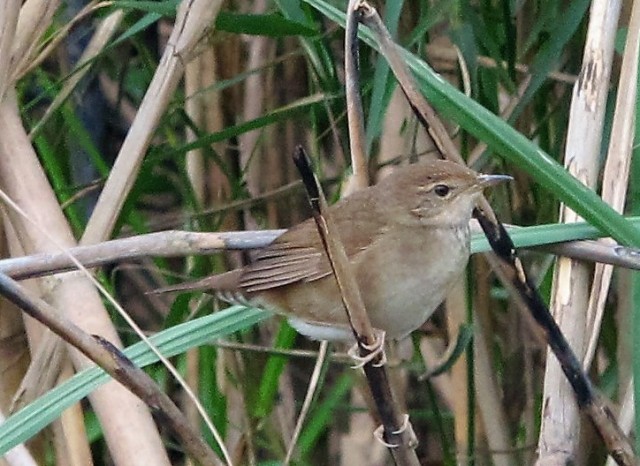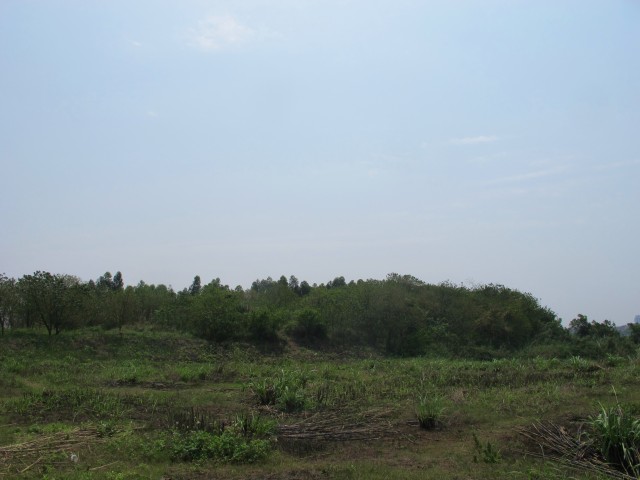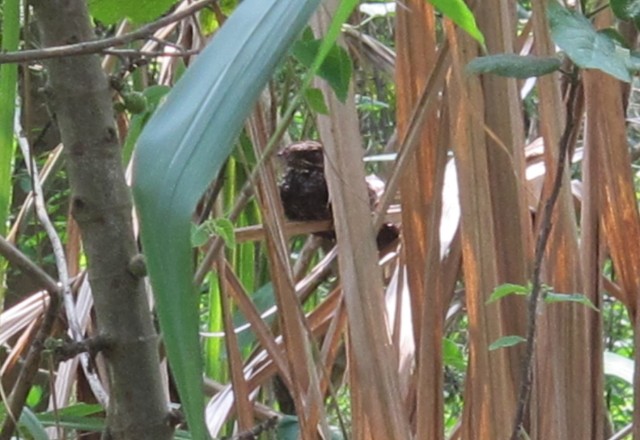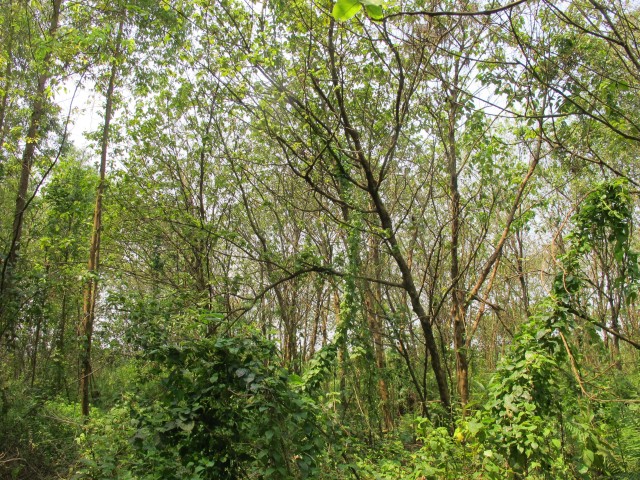
If you’d told me when I moved to Hanoi at the end of February that I would find myself living just a 10-minute cycle ride away from one of the best birding spots I have ever experienced, I wouldn’t have believed you.
The Red River is a major migratory flyway which passes through the heart of this noisy, polluted, crowded city. There isn’t much space for birds here – urban development is rife, and most of the land that hasn’t yet been built upon has been given over to high-intensity agricultural fields and banana plantations, neither of which are very good for birds.
However, on the “Red River Island” (which is actually only an island in the wet season), a few small pockets of undisturbed habitat remain. Foremost among these is a small wood, only about two hectares in size, which offers practically the only decent cover for migrant birds for many miles around. Combined with nearby patches of remnant tall grassland, this area is an oasis in the urban sprawl for tired migrants as they follow the course of the river.

I’ve been visiting the area since early March, with a running total of 11 visits spread over 20 days, and have so far recorded an impressive 104 bird species. The best area by far is the small wood, but I’ve visited other parts of the island too, and depending on time I quite often check out an area of swampy ponds halfway along the western edge as well as the wood.
I’ll start with some of the “silly” birds I’ve seen in the wood. The other day, there were two Wedge-tailed Green Pigeons in there – quite what they were doing so far away from their preferred habitat of montane forest is anyone’s guess. This morning, I flushed a Grey Nightjar on two occasions, even managing to get a very poor photo of it perched in a bush. A small flock of Red-billed Blue Magpies is resident, they usually fly in from the north-west and pass through the wood before disappearing – where do they go? – it seems remarkable that they can survive here. Equally baffling, a small flock of Masked Laughingthrushes have been regularly seen for at least a year, and have reportedly even bred – given the amount of bird poaching and trapping that occurs in Vietnam, it’s amazing that they are still alive. The local Red-breasted Parakeet could have hopped out of a cage, but the fairly frequent Blue Whistling Thrushes – of both the yellow-billed and dark-billed races – may well be genuine wanderers.

The birds here can make you feel like you’re in some remote montane forest a long way from the city. Bianchi’s Warbler, Claudia’s Leaf Warbler, Sulphur-breasted Warbler, White-throated Fantail, Black-naped Monarch, Grey-headed Canary-Flycatcher, Rosy Minivet, Greater Racket-tailed Drongo and Chestnut-flanked White-eye are just some of the forest birds that I’ve encountered in the wood so far.
Other species are perhaps a little more expected as migrants here. I hear thrushes on every visit, but they are invariably very wary, and masters of melting away into the treetops. The majority of those I have seen have turned out to be Japanese Thrushes, but I have also notched up several very smart Grey-backed Thrushes and one Black-breasted Thrush. Judging by past reports, flycatchers are something of a specialty here – these start to appear in mid-March, with several beautiful Blue-and-White Flycatchers during my last couple of visits as well as long-staying male Hainan Blue and Hill Blue Flycatchers. I’m looking forward to the prospect of encountering a wide variety of spring-plumaged flycatchers during the peak month of April.
No trip to the wood would be complete without spending a while trying to track down some skulkers. You get the feeling that almost anything could be lurking in the quite dense undergrowth under the trees, with “tick”, “tack”, “tseep” and “churr” calls often heard deep within the thickets. Some of the easier birds to find – with patience! – include Dusky Warbler, Asian Stubtail and Siberian Rubythroat, while others I have been lucky enough to catch a glimpse of include Rufous-tailed Robin, Manchurian Bush-Warbler, Brownish-Flanked Bush Warbler, and fairly regular Tristram’s Bunting.
Yellow-bellied Prinias and Common Tailorbirds are annoyingly common in the undergrowth – the usual rule of thumb seems to be that if you can actually see it, it’s probably going to turn out to be one of these two!

Outside the wood, towards the northern end of the island, a few patches of tall grassland remain, although this is being rapidly encroached by agricultural land. A few days ago, I saw two Chinese Penduline Tits here – this species has overwintered in the Red River area in previous years, but its official status is rare vagrant to the south-east Asia region. I’ve also seen Crested Bunting in this area twice in the past week, apparently two different individuals. There is a small pond here which occasionally has a lingering Pied Kingfisher or Green Sandpiper. On one occasion, I was very surprised when a Baikal Bush Warbler popped out of the grass right at my feet, even allowing me to take a photo – a rare opportunity indeed, as this locustella is known to be a master skulker!
I have marked the location of the wood on this Google Maps link .
Another worthwhile spot for those with the time is an area of grassland and ponds along the western edge of the island. Citrine Wagtail, Red-throated Pipit and Bluethroat always seem to be hanging around, and I’ve also had crippling views of Lanceolated Warbler, Common Rosefinch, and Little Bunting among other goodies. The general area on Google Maps is here.
One fly in the ointment of the Red River Island is – predictably in Vietnam – the activities of bird poachers here. Bird traps and mist nets are commonly encountered, especially near the ponds along the western edge, and I’ve also come across poachers mist-netting in the small wood. Their main targets appear to be munias (in the traps) and white-eyes (in the nets), but surprisingly there are still plenty of Scaly-breasted Munias and Japanese White-eyes on the island despite the extensive trapping.
I hope this short account of the wonders of the Red River Island will encourage other birders to visit this spring. If you come, do let me know what you see! (and submit your sightings on eBird).
Full List of Birds Seen at Red River Island, Hanoi, March 5th-25th 2016:
- Grey Heron
- Chinese Pond Heron
- Black-shouldered Kite
- Grey-faced Buzzard
- Crested Goshawk
- Black Kite
- Peregrine
- White-breasted Waterhen
- Ruddy-breasted Crake (heard only)
- Eurasian Moorhen
- Red-wattled Lapwing
- Little Ringed Plover
- Common Sandpiper
- Green Sandpiper
- Barred Buttonquail
- Feral Pigeon
- Oriental Turtle Dove
- Spotted Dove
- Wedge-tailed Green Pigeon
- Plaintive Cuckoo
- Asian Koel
- Greater Coucal
- Lesser Coucal
- Grey Nightjar
- Common Kingfisher
- Pied Kingfisher
- Red-breasted Parakeet
- Rosy Minivet
- Brown Shrike
- Burmese Shrike
- Long-tailed Shrike
- Black Drongo
- Ashy Drongo
- Greater Racket-tailed Drongo
- White-throated Fantail
- Black-naped Monarch
- Red-billed Blue Magpie
- Grey-throated Martin
- Barn Swallow
- Red-rumped Swallow
- Grey-headed Canary-Flycatcher
- Japanese Tit
- Chinese Penduline Tit
- Red-whiskered Bulbul
- Sooty-headed Bulbul
- Light-vented Bulbul
- Black Bulbul
- Asian Stubtail
- Manchurian Bush-Warbler
- Brownish-flanked Bush-Warbler
- Dusky Warbler
- Radde’s Warbler
- Pallas’s Warbler
- Yellow-browed Warbler
- Claudia’s Leaf Warbler
- Sulphur-breasted Warbler
- Bianchi’s Warbler
- Thick-billed Warbler
- Oriental Reed Warbler
- Black-browed Reed Warbler
- Lanceolated Warbler
- Baikal Bush-Warbler
- Zitting Cisticola
- Common Tailorbird
- Yellow-bellied Prinia
- Plain Prinia
- Japanese White-eye
- Chestnut-flanked White-eye
- Masked Laughingthrush
- Hainan Blue Flycatcher
- Hill Blue Flycatcher
- Blue-and-White Flycatcher
- Taiga Flycatcher
- Rufous-tailed Robin
- Bluethroat
- Siberian Rubythroat
- Siberian Stonechat
- Pied Bushchat
- Grey Bushchat
- Blue Whistling Thrush
- Japanese Thrush
- Black-breasted Thrush
- Grey-backed Thrush
- Daurian Starling
- Crested Myna
- Great Myna
- Olive-backed Sunbird
- Citrine Wagtail
- Manchurian Yellow Wagtail
- White Wagtail
- Grey Wagtail
- Richard’s Pipit
- Paddyfield Pipit
- Red-throated Pipit
- Olive-backed Pipit
- Crested Bunting
- Tristram’s Bunting
- Little Bunting
- Black-faced Bunting
- Common Rosefinch
- Oriental Greenfinch
- Eurasian Tree Sparrow
- Scaly-breasted Munia
- White-rumped Munia

i’ve been wanting to explore this area but never got the chance when i visit hanoi, so i’m hoping to go there later this week. any recommended time to go? and where’s the best way to access the locations you indicated in the map? thanks.
LikeLike
Great info!
I’ll be spending the morning around North Wood Tuesday 6 Feb 2018 on a visit from Dubai. If you are around 🙂
Tommy Pedersen
LikeLike
Hi Tommy, sorry for the late reply! I am living in the USA now, so I wouldn’t have been able to meet you anyway. Did you visit the North Wood? Is there anything left there now? Habitat destruction was happening at an alarming rate when I was last there 😦
LikeLike
North wood alive and kicking – identical to the Google Earth image.
Got a lifer: the Bush Chat. VERY pleased!
https://ebird.org/view/checklist/S42535376
I will visit this spot on every Hanoi layover I get.
where in the US are you based?
As a pilot with Emirates, I might just fly there.
Or, if you pass by Dubai:
http://www.uaebirding.com
Stay warm,
Tommy
LikeLike
Congrats on your Gray Bushchat – although I’m surprised you needed it as you seem to have seen a lot of birds! I’m both surprised and delighted that there is anything left of the North Wood. I’m based in Houston. Look me up if you stop over! Happy for some company on birding trips to the coast here 🙂 Cheers, Dominic.
LikeLike
I spend a lot of time there but am still nowhere near your impressive list. North Wood is all but got now. However, yesterday I found another small wooded area which yielded Black-naped Monarch, Red-billed Blue Magpie, Ashy Drongo, Plaintive Cuckoo, Greater Coucal buidling a nest, and Japanese Tits. I believe I also saw a Radde’s Warbler there but I suck at warblers.
LikeLike
Hi Hanno, hope you’re well. I’d be interested to know the exact location of the wooded area where you saw those birds. Spring 2016 was pretty impressive on Red River Island for a wide range of migrants including some very unexpected species, I was lucky enough to be able to cover the area thoroughly almost every day throughout the spring migration that year. However, sadly I doubt that such a bird bonanza will ever be repeated there due to the degradation of the habitat, not to mention the hunting. Cheers, Dominic.
LikeLike
Hi Dom,
It is here: Check out
Bird forest
My Places • Attraction
ge0://s0ue6E9LJa/Bird_forest
http://ge0.me/s0ue6E9LJa/Bird_forest
Went last Sunday but it was dead, way too hot.
Regards,
Hanno
LikeLike
I did visit that wood a few times. I remember it being pretty dense and hard to get into. I did see a few birds around the edge, from memory the best one was Hodgson’s Hawk-Cuckoo. It probably gets a larger share of birds these days, seeing as it probably now constitutes pretty much the last wooded area on the island.
LikeLike
Hi Dominic,
I tried to send you a link with the exact location with Maps.me but that does not seem to be working. The very small, fenced patch of trees is pretty much in the middle of the island, about halfway between Long Bien Bridge and the flower garden.
Regards,
Hanno
LikeLike
Hi. Great read! Thanks for the tips! I am visiting Vietnam Hanoi in September. Planning on visiting REd River but not sure exactly where. Would I need any form of transportation to explore the Red River Island? Any precautions? Many dogs around? Thanks.
LikeLike
Hi Zaim! The northern end of the Red River Island, which back in 2016 included most of the best birding areas, can easily be covered on foot. However, the island is quite long, so visiting the south parts of the island would need transportation. A bicycle is the best way to explore the island as many of the trails are little more than single-track paths. I never had any issues there with dogs. I hope there is still some good habitat (and birds) remaining, as back in 2016 the few remaining areas of cover for migrant birds were steadily being degraded or removed. Good luck!
LikeLike